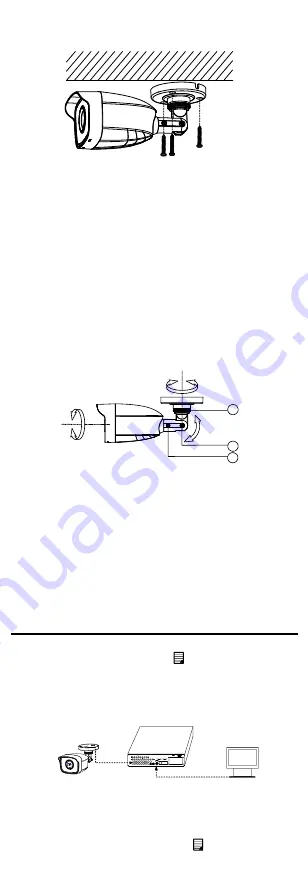
3.
Attach the bracket to the ceiling and secure the
camera with supplied screws.
Figure 2-12
Fix the Camera to the Ceiling
Notes:
The supplied screw package contains
self-tapping screws, and expansion bolts.
For cement ceiling, expansion bolts are
required to fix the camera. For wooden ceiling,
self-tapping screws are required.
4.
Route the cables through the cable hole, or the side
opening.
5.
Connect the cables, such as the power cord and
video cable.
6.
Check whether the image on the monitor is gotten
from the optimum angle. If not, adjust the camera
according to the figure below to get an optimum
angle.
3
2
1
Pan Position
[0° to 360°]
Rotation Position
[0°to 360°]
Tilt Position
[0°to 180°]
Figure 2-13
3-axis Adjustment
1).
Loosen the No.3 screw to adjust the pan
position [0° to 360°]. Tighten the screw after
completing the adjustment.
2).
Loosen the No.2 screw to adjust the tilt position
[0° to 180°]. Tighten the screw after completing
the adjustment.
3).
Loosen the No.1 screw and rotate the camera [0°
to 360°]. Tighten the screw after completing the
adjustment.
3
Menu Description
Purpose:
Call the menu by clicking button on the PTZ Control
interface, or click Iris+.
Steps:
1.
Connect the camera with the TVI DVR, and the
monitor, shown as the figure 3-1.
Camera
TVI DVR
Monitor
Figure 3-1
Connection
2.
Power on the analog camera, TVI DVR, and the
monitor to view the image on the monitor.
3.
Click PTZ Control to enter the PTZ Control interface.
4.
Call the camera menu by clicking button, or click
Iris+.















